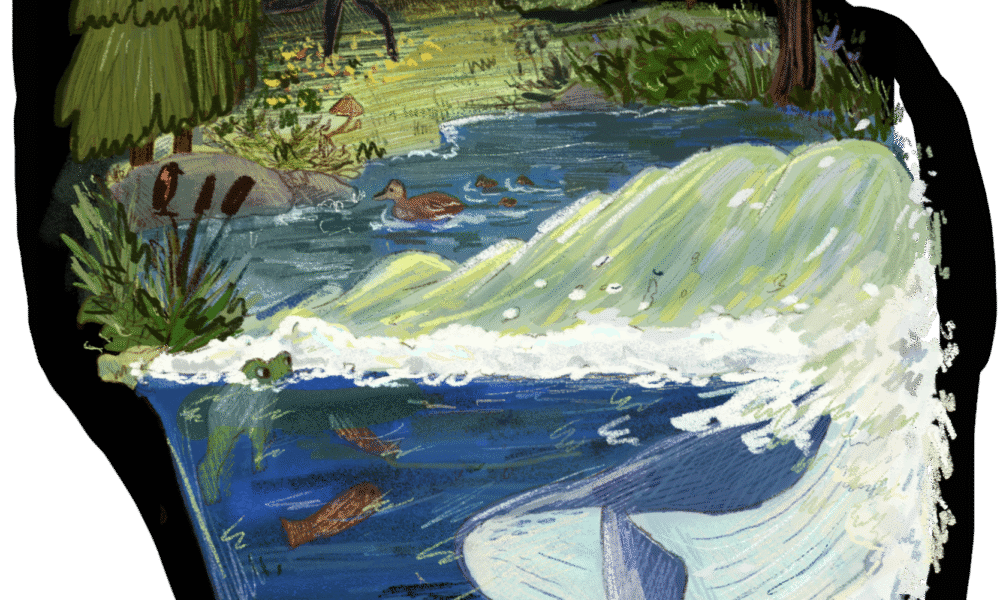Human activity has degraded or destroyed many ecosystems; an estimated 75 per cent of the Earth’s land surface has been significantly altered by human activity. This degradation contributes to climate change, reduces water quality, degrades soils, and disrupts pollination patterns. Restoration of degraded ecosystems may serve as a solution to recover the services that these ecosystems provide.
Catherine Destrempes, a McGill graduate alumnus working in the Bennett Lab from the Department of Natural Resource Sciences and the Bieler School of Environment, worked with collaborators to investigate whether ecological restoration can restore ecosystem services. She conducted an analysis at the landscape level in the Montérégie administrative region, located south of Montreal and primarily covered by croplands. With ecosystem service modelling, she determined how increasing the scope of natural ecosystems in Montérégie would affect seven ecosystem services, including pollination, water quality, recreation, maple syrup production, and food production.
But what is ecological restoration?
The Society for Ecological Restoration defines ecological restoration as “the process of assisting the recovery of a native ecosystem that has been degraded, damaged or destroyed.” Restoration typically aims to guide ecosystems toward a reference system, often their pre-disturbance state. It is a nature-based solution for sustainably managing ecosystems, complementing conservation— which focuses on protecting existing ecosystems—in the overarching goal of safeguarding biodiversity.
Together, restoration and conservation are complementary approaches to preserving biodiversity. While the former rebuilds degraded ecosystems, the latter protects biodiversity and prevents extinctions.
Ecosystem recovery is particularly important in biodiversity hotspots—regions with high biodiversity and threatened by human activities. In the 36 hotspots identified by Conservation International, which range from the Atlantic Forest in Brazil to the North American Coastal Plain, less than 30 per cent of the historical ecosystems remain. By increasing the habitat extent for species, they will be more resilient to global change.
The restoration of ecosystems can also improve the connectivity of fragmented habitat patches. This is crucial for allowing species to migrate and facilitating natural flows, thereby making systems more resilient to climate change. It is also generally accepted that creating suitable habitats within any natural patch of land can increase the resilience of species and populations.
Restoration ecology is an interdisciplinary field that draws knowledge from various disciplines, including economics, social sciences, and ecology, to assist in the recovery of ecosystems and the services they provide.
How does ecological restoration work?
Ecological restoration projects begin by setting realistic, measurable, and socially acceptable goals. Since it is typically not possible for ecosystems to recover to their exact pre-disturbance state, it is crucial to determine the target reference state and identify the ecosystem services this state will include. Such services include flood control, pollination, recreation, mental well-being, and climate change mitigation.
To establish goals, key stakeholders must agree on restoration objectives. Local communities must be directly involved so that the objectives align with their needs. Destrembles’ research may bridge the gap between the environmental landscape and human needs.
“[Our] research was more about how we can use [the degraded land] we presently have available and take the most benefit out of it, for nature and for us,” Destrempes said in an interview with The Tribune.
Destrempes also supported the connection between social sciences and environmental sciences. For example, to recover ecosystems in farmlands, the farmers’ perspectives on the project must be taken into account.
“The first thing is getting farmers’ opinion on the subject,” Destrempes said. “What do they want to do? What are they willing to be part of? At the end of the day, it is their land. They are the ones deciding. They know these pieces of land way better than we do, and they might have insights from our spatial analyses we would never know.”
Before implementing any intervention, restoration project managers assess the type and magnitude of human disturbances responsible for degradation. Severely degraded systems, such as former mining sites and areas with a history of extensive fires, typically require intensive interventions.
When an ecosystem has not been severely degraded, natural recovery is usually effective and cost-efficient. However, it is less effective in the presence of invasive species, such as weedy grasses. Sometimes, small interventions are required. For example, if fires prevent the growth of native species, fire management will aid the ecosystem in natural recovery.
When natural recovery is inefficient, more active strategies can be implemented. Restoration project managers must gather knowledge about the ecosystem’s functioning to help determine better strategies.
Let us compare two case studies: The recovery of a drained peatland—a wetland where dead plant materials accumulate due to slow decomposition—versus the recovery of a deforested tropical rainforest. The restoration of the peatland requires the recovery of its hydrological flows. In the tropical forest, the lack of animal-mediated seed dispersal hinders forest regeneration, indicating that facilitating seed dispersal or introducing plants may be more effective.
Most active restoration strategies have historically focused on vegetation recovery, as plants form the foundation of habitats. Revegetation can occur through nursery-grown seedlings, direct seeding, or encouraging natural seed dispersal by installing structures that attract animal seed dispersers. Local communities can participate in the management of the nursery, tree planting, and seedling maintenance.
“When people are on board, they will take care of these pieces of land,” Destrempes said.
Farmers may be reticent about restoring parts of their land because patches of natural habitats can decrease agricultural yields by increasing shading; however, this may be compensated for by increased pollination and resilience against extreme events. For example, wetland ecosystems store a significant amount of water and can provide water to surrounding areas during droughts. To support farmers in Montérégie, the Alternate Land Use Services (ALUS) Montérégie program can help farmers restore parts of their land.
Environmental monitoring is essential after any intervention, yet it remains one of the weakest aspects of restoration practice. Community involvement has the potential to strengthen this stage.
Importantly, ecological restoration projects should be carefully managed with a landscape-level perspective in mind to ensure that the recovery of one ecosystem does not lead to the degradation of another—a phenomenon referred to as a spillover.
Overall, restoration projects lie at the intersection of social and ecological dimensions. Although these projects are grounded in ecological principles, their success depends on the involvement of local people throughout the process.
How may ecological restoration help ecosystem services?
Surprisingly few studies have rigorously measured the impact of ecological restoration on ecosystem services. Weak monitoring of restoration projects, combined with the use of inadequate monitoring indicators, has limited the evidence base for effective restoration practices.
It is in this context that Destrempes’ study comes into play. She found that the recovery of ecosystems can yield benefits across the landscape.
“The main thing that we found that was very interesting is that, when we restore a piece of land, […], it actually has an impact […] in the zone of restoration but also around that zone […],” Destrempes said. “To say it plainly, if we restored [one] field, the surrounding field also had increased ecosystem services [….] We can use [the spillover effect] to our advantage. We can […] put restoration patches [across the landscape] to have a compounded effect.”
She also found that ecosystem services had different responses according to the extent of the area that is restored. Some services were significantly increased by implementing very few restored areas. This suggests that, depending on the specific services targeted for improvement, extensive land restoration may not always be necessary.
A meta-analysis also found that increases in ecosystem services were linked to increases in biodiversity, and that tropical ecosystems typically yielded higher increases in ecosystem services than temperate ecosystems.
It is also important to acknowledge that ecosystem recovery can be a slow process. For example, secondary forests—forests that have regenerated after being destroyed—may require a century to recover their original biomass and around 50 years to recover species diversity.
Altogether, carefully managed and targeted ecological restoration is promising for meeting biodiversity conservation targets. Major global restoration projects are currently underway, such as the Bonn Challenge, which aims to restore 350 million hectares of degraded landscapes by 2030. From social scientists and economists to ecologists, there is a place for everyone in restoration ecology—be part of the movement!









